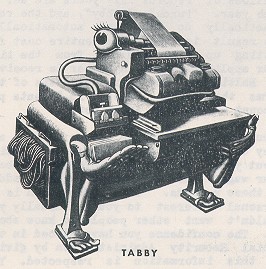In December 1955 the Social Security Administration published
a 16-page illustrated explanation of the procedures it used to maintain
Social Security records on the nation's covered workers. It traces
the process of assigning Social Security numbers (SSNs) and establishing
the central record for each wage earner who is issued an SSN.
This booklet is a fascinating glimpse at the world of automated data
processing circa the mid-1950s. The various pieces of equipment used
in the processing of Social Security records are illustrated by "cutesy"
drawings, which "personalize" in some way each of the major
pieces of equipment.
Interestingly, with the exception of the electronic "Brain,"
the equipment and procedures in use at the end of 1955 had changed
very little from those first put in place in the Candler Building
in the Fall of 1936. However, this booklet was poised on the edge
of a dividing-line of history. Very soon the electronic revolution,
of which the "Brain" was SSA's advance-guard, would radically
alter the processes and equipment used in the Social Security system.
|
|
DEPARTMENT OF HEALTH, EDUCATION,
AND WELFARE
SOCIAL SECURITY ADMINISTRATION
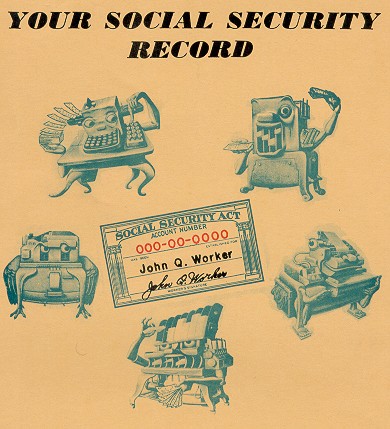
BUREAU OF OLD-AGE AND SURVIVORS INSURANCE
DIVISION OF ACCOUNTING OPERATIONS
|
The figures of the machines, with the exception of the interpreter
and the electronic calculating punch, that are used In this booklet
were drawn by artist Boris Artzybasheff for a brochure entitled -"540" published by TIME INC. They have been reproduced with the kind permission
of the publishers.
|
|
YOUR SOCIAL SECURITY RECORD
Social security for old age and for the surviving dependents of
deceased workers is social insurance. Social security is one democratic
way of insuring for your own future and for the future of your dependents.
You pay a tax based on the earnings paid to you in employment covered
by this social insurance plan. Your employer pays an equal amount.
While technically these payments by you and your employer are called
taxes, they might well be considered to be insurance premiums. The
money goes into a special trust fund and you are given credit for
the earnings on which you and your employer paid taxes, on an individual
record kept for you in the Division of Accounting Operations in
Baltimore.
Insurance payments will be made to you out of the Trust Fund after
you reach age 65 if you are insured and have retired. To be considered
as being retired you must be 65. Also if you earn more then $1,200
in a year, from any type of work whether or not covered by social
security, some of the checks for that year may not be payable if
you are under 72. If you are 72 or over then there is no limitation
on the amount of money you may earn and still be considered as being
retired. In the event of your death before age 65, your survivors
will be paid insurance benefits out of the Fund. These payments,
by laws are based on a formula applied to the average of your past
earnings. Because of this the record of your account is kept so
as to show the earnings on which you and your employer paid taxes
rather than to show just a record of your tax or "premium"
payments. That record is a very simple but a very complete one;
but YOU for whom the records are kept, now number over 115,000,000
Americans.
Here we have one form of an American insurance system and it is
administered in a characteristically American way. America's mechanical
genius was called upon to help some of the ablest of the Government's
experts in record keeping to handle this truly gigantic task of
establishing and maintaining the insurance records for this tremendous
number of people.
Machines that can literally read, compare, file, sort and print
records were brought into use to do the job. In some cases machines
were readapted to do the job. In other instances new machines were
invented to aid in the work. With the development of electronics,
more and more electronic equipment has been adapted or specially
devised to aid in the vast amount of record keeping. Today the machines
that do the work do everything but think and now technicians are
experimenting with the possible use of machines that would seem
to do just that and which will have memory cells as well.
Your insurance record starts when you apply for a social security
account number. You fill out an application form in which you give
identifying information about yourself and usually you give the
form to a person in a Social Security District Office or you may
mail it to such an office. The District Office person checks the
completeness of the application and then fills in a pre-numbered
social security account number card with your name and the date.
The number on your card is transcribed on to your application. Maybe
you are a little curious about the number. Maybe you wonder if it
has any special significance. Well, it has. The social security
account number always has nine figures. It is broken, by means of
dashes, into three parts. The first part, called the "area"
number, consists of three figures, the second part, known as the
"group" number, is of two figures, while the third part,
called the "serial" number, has four digits. Your social
security number looks like this on your account number card:
1
|
|
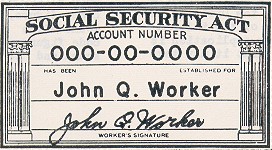
The "area" number indicates the state in which you first
filed your application for a social security account number. In
the more sparsely populated states only a few "area" numbers
have been assigned. In the more densely populated states many "area"
numbers are assigned. New Mexico, for example, has, at present,
only one area number assigned to it and that is the number "525".
On the other hand the state of New York has been given eighty-five
"area" numbers, ranging from "050" through "134."
There is no special significance, from the standpoint of geographical
or other coded data, attached to the "group" or "serial"
numbers. They are significant, however, in that they identify you
as an individual. That particular series of figures in your social
security number is never assigned to anyone else and it is always
kept in your name. By separating the account number into three groups,
it helps to reduce the possibility of transposing figures when the
employer copies his worker's number onto his payroll records and
when he copies it onto the informational portion of his social security
tax return.
When you fill in your application for a social security number,
you are setting into motion an assembly line of machines for setting
up your social security records. Your application for a number and
a copy of your social security account number card are forwarded
to the Division of Accounting Operations in Baltimore by the Social
Security District Office that issued the number. Their receipt is
checked against an advice of transmittal and then they are given
to a punch machine operator. She puts some of the information on
your application into a code form in order that it may take up less
space on your records. For example, your sex is coded. If you are
a male you are given the code symbol "1" to indicate your
sex whereas if you are a female your code for sex is "2".
Your color and your date of birth are also coded and finally a code
is given you for your last name.
The code for the surname, known as the "Soundex" code,
classifies your name by the major consonants in it. The code consists
of the initial letter of your last name, and three digits representing
the first three significant consonants in your name. If you do not
have three consonants in your surname after the initial letter then
zeroes are added to your code to make up a three digit figure. In
this system of coding the vowels and the letters "H" and
"Y" are not coded. The other consonants are classified
by sound. Like sounds are grouped together. After the coding has
been completed, the machines take over and mechanical record keeping
gets under way.
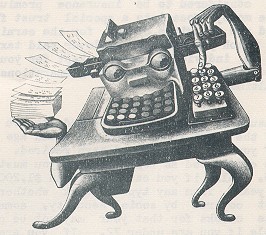 |
|
PUNCH
|
The person who codes the information on your application also operates
an alphabetical card punching machine, "Punch" for short.
"Punch" is quite a gadget. On the surface he eyes the world
with the face of a typewriting key board. However, no typewriter is
he. His operator taps his keys and for every tap he pierces a card
and cuts into it rectangular holes representing information in code
form. Two holes in a column represent a letter and one hole represents
a figure. The operator taps out your number, name, date of birth and
other information about you from your
2
|
|
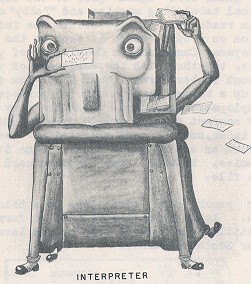 |
application for a number into a card that is called an "Actuarial
Card." Having placed the information about you in punch card
form other machines can later file, sort, and print this information
as it is needed.
First of all, your card is placed into a reading and printing machine
called an Interpreter. Interpreter can't read Russian, but he can
read the punched hole codes in your card and then he can translate
the information back into English and finally print it in English
on your card. Quite a boy, that Interpreter!
After Interpreter gets through with your card, it is given to a
reviewer to check and to make sure that the information you gave
has been correctly coded in the card and also agrees with your name
and number as they appear on the copy of your social security account
number card.
When your information has been checked, your card goes to an automatic
reproducing machine which like an old mother hen turning out one
egg after another, each just like the one before it. This machine
makes an exact duplicate of your punch card and this, too, is given
to our friend Interpreter to be translated into printed English
and then to be placed in a file in its proper numerical position.
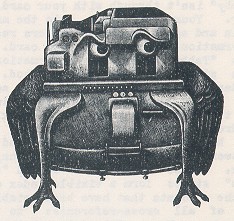 |
|
THE HEN
|
Your first punch card then goes on to a machine known as an Alphabetical
Tabulator, "Tabby" is quite a character. She feels the
holes in your card and reads them like a blind man reading Braille.
Having read them, she decides you ought to see them too, so she
prints all of the information onto a listing form. This listing
goes through Tabby as a continuous form, but after Tabby has printed
all the information about you and ninety-nine others who have just
gotten social security numbers the listing is separated into pages
which are bound by means of post binder, into books to form a numerical
register of all of the amounts that have been established.
3
|
|
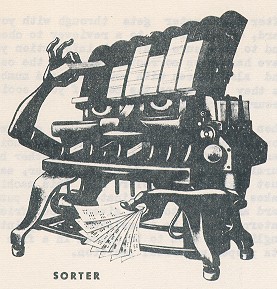
"Tabby" isn't through with your card, however, your card
goes into the machine again and again "Tabby's" fingers
read the information punched into your card. This time "Tabby"
prints the information on a thin strip of paper-covered wood. This
wooden strip is placed in a panel according to the Soundex code
for your surname and the panel is hung in a rack. One hundred and
nineteen strips besides yours can be placed in a single panel and
up to sixteen hundred panels can be hung on a rack. Those racks
of so-called "flexoline" strips form a Visible Index of
all of the accounts that have been established and of all cross-references
to those accounts. Your strip joins that of some one hundred and
fifteen million other account number holders and of all the cross-reference
strips needed for them to make up the largest visible index in the
world--over one hundred and fifty million file entries.
While "Tabby" reads your life history, an automatic microfilm
camera photographs your original application for a social security
number on 16 millimeter film. That film is placed in a film file
in another building as a safeguard against fire, or destruction
by any other means, of the original record. If your original application
is ever damaged, lost or misfiled, a duplicate can quickly be prepared
from the microfilm. Your original application for a number is then
sent to a file to be placed in its correct numerical position.
Your punch card again goes to the alphabetical tabulating machine
and "Tabby" once again reads it. "Tabby" prints
the information on a card which is sent to the Unemployment Compensation
Commission of your State, together with the duplicate of your account
number card. Your State can then set up a record for you for the
purpose of unemployment insurance, using the copy of your account
umber card to make a numerical index, and the card prepared by "Tabby"
to form an alphabetical file. Some State agencies, however, use
a punch card for this file.
Your punch card then goes to a holding file. Later this file is
used to furnish statistical data about the people insured under
Social Security.
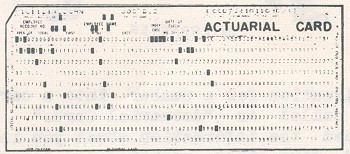
So there now is on file your original application for a number,
a microfilm copy of that application, an entry in a "Numerical
Register of Accounts Established," an entry by name code in
a visible index, a statistical punch card, and a master punch card
(called an "Employee Annual Summary Card') for your account.
In addition, your State has been furnished with two card forms to
set up unemployment insurance records for you. Sounds like a lot
of work, doesn't it? Sounds somewhat expensive, too, doesn't it?
Well, it isn't. Millions of records like yours are set up each year.
"Punch", "Tabby", and the rest practically do
the work automatically. The result is that the entire cost for setting
up your records from the time your application for a number in received
in Baltimore, including the costs of the forms themselves, is only
13.1 cents per account -"Believe it or not."
A number of records are set up for you and they contain quite a
lot of information about you. Later more information about your
wages and employment will be added to those records. This information
is of personal interest to you and usually you wouldn't want other
people to know about it. The confidence you have placed in the Social
Security Administration by giving it this information is respected.
You
4
|
|
have its pledge that the information will be kept confidential.
No unauthorized person in allowed to have access to your records.
The employees of the Social Security Administration are forbidden
under heavy penalties to violate this rule under any circumstances.
The information about you and your employment history is in safe
hands. Only you, or one of your survivors, who may be entitled to
benefits on your account, or a third party authorized by you may
see these records.
In addition to the records set up for you, it is necessary for your
employer to register with the Social Security Administration. He
files an application for an "Employer's Identification Number."
On this application he gives his name, the name of his business
enterprise, his business address, the type of organization being
operated, the number of people working for him, the nature of his
business, such as the service he renders or the goods he sells,
or the material he manufactures. He also tells when he went into
business and how he acquired his business. This application by your
employer is forwarded to the district office of the director of
internal revenue. There the application is checked to the files
to determine if your employer was previously assigned an identification
number. If a number was assigned, the old number is reactivated;
if not, a new number is assigned. The numbers are assigned in numerical
sequence in the order that the forms are processed. After assigning
a number, an addressograph plate is embossed to show your employer's
name, address and identification number. This plate will be used
in the future by the director to address tax returns to your employer
for each quarter in which payments are due.
As a part of the registration, the director uses the plate to prepare
a notice of the number assigned, which is mailed to your employer,
and a form letter on the letterhead of the Social Security Administration
District Office, which is sent to your employer as a notice that
the local District Office is ready to help him with any questions
or problems he may have in connection with the social security program.
Also, the addressograph plate is used to print your employer's name
and identification number in numerical sequence on a register page
which is forwarded with the second page of all other employer applications,
included on the same register page, to the Social Security administration.
The first page of your employer's application is filed by the collector.
When the second page of your employer's application and the related
register of employer identification numbers assigned are received
by the Social Security Administration, the register page is filed
as a permanent numerical register of employers assigned numbers
in the collector's district from which it was received. The application
is then given to a coding clerk who gives it a code to show the
geographical location of the employer by State and by county. Another
code is given to show the type of industry in which your employer
is engaged.
Your employer's application is then routed to a punch machine and
"Punch" takes over the job of putting all of the information
about your employer in coded punch hole form in a card. The operator
taps out on "Punch's" keyboard your employer's name, the
identifying number that has been given to him, the code for his
location and type of business, the time he went into business and
how he acquired the business. These, too, are in code. When "Punch"
has completed your employer's card it passes on to the Interpreting
machine. "Interpreter" reads the coded punch holes, translates
them into English and prints the English translation across the
top of your employer's card.
5
|
|
The card is then sent to another machine, technically known as
an alphabetical verifying machine but it might be better known as
the "Eye." The "Eye" looks like our old friend
"Punch" but his job is to check up on "Punch."
If a hole has not been correctly punched the "Eye" will
discover it when his operator taps out the correct information on
his keyboard. If the "Eye" discovers an error, your
employer's card is repunched correctly.
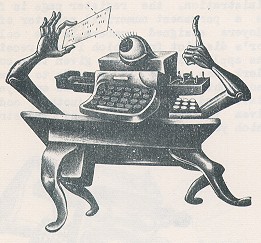 |
|
THE EYE
|
After making sure that all your employer's information has been correctly
punched into the cards the card is routed to an automatic reproducing
machine, the "Hen" to make up a duplicate card. That duplicate
card goes to an interpreting machine and "Interpreter" prints
the punched information across the top of the card.
The first card is used to supply the Bureau of the Census with statistical
information for its census of the births and deaths of businesses
throughout the country. The second punch card is for use in preparing
future statistical tabulations in connection with the wages reported
by your employer for you and your fellow employees.
If you are a household worker, your employer is assigned an identification
number in the manner described above, with the exception that it is
not necessary for her to file a regular "Application for Identification
Number." She can just notify the director that she wants to report
your earnings for social security purposes. The director will then
prepare and file an addressograph plate for her in a special file
so that she will be sent a simplified form each quarter for reporting
your earnings. The Division of Accounting Operations will include
your employer in their records with the forms prepared from the director's
addressograph plate but will not prepare punch card records for her.
It may be that your employer is a State or local government organization,
which has elected to be covered under Social Security by special agreement.
In this case, your particular organization will be listed with the
others in your State when the State's agreement with the Social Security
Administration is made. The directors of internal revenue do not collect
the social security contributions for these employers so the list
of organizations in your States which will report for social security
purposes is sent directly to the Division of Accounting Operations.
Employer identification numbers are assigned by the Division of Accounting
Operations in a special series and records similar to the ones for
regular employees are set up. Notice of the identification number
assigned and the forms for reporting your earnings each quarter will
be forwarded to your employer by the Division of Accounting Operations
instead of the director of internal revenue. Also, your employer will
pay the contributions to a Federal Reserve Bank, instead of to the
director of internal revenue, for the credit of the Secretary of the
Treasury and the Federal Old-Age and Survivors Insurance Trust Fund.
6
|
|
You may wonder as to just what the employer identification number
is. It is nothing more than a nine digit figure broken into two
parts. The first two digits are separate from the last seven. The
first two figures thus separated indicate the code for the internal
revenue district to which your employer must pay his social security
taxes and submit his wage reports. There are some 66 internal revenue
districts in the United States, (68 including Puerto Rico and Virgin
Islands) each servicing a fixed section of the country. Your employers
in filing his application for an identification number, must file
through the office of the director who services the geographical
area in which he is located. The last seven figures are not significant
from the standpoint of showing a geographical location or any other
information. They are issued in straight serial number order as
the applications for identification numbers are received. They are
significant in that a particular serial number exactly identifies
the employer to whom it is assigned and it is never used for any
other employer.
The use of identifying numbers for both employers and employees
enables the Social Security Administration to correctly identify
reporting employers and the employees whose wages they report. Every
three months the directors of internal revenue have the addressograph
plates for all employers in their districts withdrawn from file
and they use these plates for heading tax return forms known as
Forms 941. Appended to the Form 941 is another form
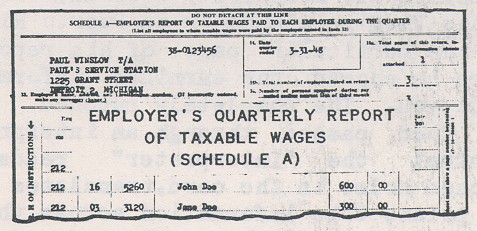
known as a Schedule A. When the employer receives this combination
tax and wage information forms he lists on the Schedule A portion
your account number, your name, and the amount of earnings that
he paid to you during the preceding three month period. He also
lists the some information concerning your co-workers who were employed
by him during that period. He indicates on the form the total amount
of wages paid by him as an employer and in the event that he needs
more than one page to show these earnings records, he shows a sub-total
for each page.
On the Form 941 itself, your employer also shows the total earnings
that he has paid during the quarter, the amount of social security
taxes that he deducted from his employees' earnings and the amount
that he has to pay as an employer, as well as any adjustments that
he may make. Some other forms for reporting are also used. For example,
if you are a household worker your employer will use a special Form
942. If you are self-employed you will use a part of your income
tax return. However, all the forms are handled in about the some
way. If you are self-employed you will make your own report; if
not, your employer will send in the forms.
He sends the combination tax return and earnings report to the office
of the director of internal revenue with his tax payment. In the
director's office a check is made to make sure that the total earnings
figure is the same on both portions of the form and to insure that
the tax deductions and remittances are correct. When this has been
done, the informational part of the return is detached from the
tax return form.
The tax return form is kept in file in the director's office; the
informational return, together with similar schedules from other
employers, is forwarded to Baltimore to the offices of the Division
of Accounting Operations. These informational returns are assembled
in groups that are called "blocks. A block will ordinarily
contain the wage reports for about 11,000 employees. A record of
the transmittal of the block is made. This transmittal record accompanies
the block to Baltimore to advise the Baltimore operations of the
employers' returns that are contained in the block. When the block
of informational returns is received in Baltimore, it is checked
to the transmittal record to make certain that all the employer
reports have been received. These blocks are of two kinds: single-page
blocks for employers who require only one page, and multi-page blocks
for employers who require more than one page. All reports for household
employers are in single-page blocks. This separation into single
and multi-page
7
|
|
blocks helps the Division Of Accounting Operations to put the blocks
of reports through operations.
After the reports have been examined an operator uses "Punch"
to prepare a card for your employer. This card shows your employer's
name, identifying number and some statistical information about
him. The card for your employer and his wage report form is then
sent to a large unit of punch machines.
Here operators use "Punch" to prepare individual wage
cards for you and for your co-workers. Using your employers earnings
report the operator will tap out the information on "Punch's"
keyboard and "Punch" will prepare an individual card for
you showing your social security account numbers your initials and
name, the amount of earnings reported for you by your employer,
and the number of the page of his report on which he submitted the
information about you. In like manner the operator will prepare
similar cards for all of your co-workers.
After "Punch" has converted your earnings information
into punched hole form, a statistically selected portion of the
wage cards are sent to the "Eye." The "Eye"
is a verifying machine and it checks the accuracy of the punching
in your wage cards. Only about 10 percent of the cards are checked
by the "Eye." The purpose of the "Eye's" operation
is to check on the accuracy of the operators of the punch machines.
By verifying the cards immediately after they have been punched,
it is possible to determine how many errors the "Punch"
operators are averaging. The error average of a very good operator
is less than 1.3 percent. If their average is found to exceed 2.25
percent all their work will be sent to the "Eye" and they
will be given corrective training. This operation is a check on
the accuracy of the operators of "Punch" and is also a
verification of the mechanical accuracy of all punch machines. All
errors made by any "Punch" operator in punching your name,
your social security number or your wages will be picked up automatically
and corrected in the succeeding operations when the cards are handled
by "Tabby" and "Choosey."
When "Punch" and the "Eye" are through with
your earnings report and all the others for your employer then your
card and the cards for your co-workers and the card for your employer
will be forwarded to a reproducing machine (the "Hen").
The "Hen" will be used this time not to prepare new cards,
but to read the information on your employer's card as to his name,
his identification number, the period for which he submitted the
wage report, the accounting quarter and the establishment number
for your employer. After the "Hen" has read this information
from your employer's card, it will automatically punch the same
information into your wage card and into the cards for your co-workers,
so that finally there is a card which records in punched hole form
your number, your name, your employer's number, a part of your employer's
name, the period in which your employer reported, the amount of
earnings that he reported that he had paid you in that period, the
code for the type of employment in which you are engaged--if agricultural,
household, federal, foreign, in the Virgin Islands or in Puerto
Rico--and the particular page of his report on which he showed the
earnings information about you. The completely punched cards are
then passed through an interpreting machine; the "Interpreter"
reads the punched holes in the card, translates them, and prints
this information across the top of the card. All the punch cards
for you and your co-workers and your employer's card are then fed
through an electrical tabulating machine. Your employer's card goes
through the machine first, and the machine reads from the card the
total amount of earnings reported by your employer. Then your earnings
card and the earnings cards of your co-workers are read by the machine
and they are totaled. The
8
|
|
the total earnings for you and all your coworkers with the total
reported by your employer. If those totals are exactly the same,
it means that your employer correctly added your wages and those
of your follow workers. Also it means that the operators of the
punch machines correctly punched the information as to your earnings
into the cards for you and the other employees working for your
employer. If the totals do not agree exactly, a check is made to
determine from the subtotals, what page of your employer's report
contains the error and then each item on that page is checked to
determine if the error is one made by the punch operator in preparing
the card or by your employer in adding the earnings. If it is an
operator's error, it is quickly remedied by repunching the card.
If your employer made a mistake then your employer's report will
be corrected and it will then be sent through the succeeding operations.
If your employer made a mistake amounting to $25.00 or more it is
necessary to correspond with him. This is done through the office
of his director of internal revenue. He is told of the error and
asked to submit an adjustment report. When your employer's report
has been verified and all errors that may have been found are corrected,
your punch card, recording the earnings paid to you by your employer,
and the cards for your co-workers go to a holding file.
Your employer's report and all the reports in the same block are
kept in sequence order and are microfilmed. Your employer's punch
card is placed with that of other employers. These cards are arranged
at the end of each quarter in employer identification number order
by the "Sorter" and listed by "Tabby" to show
such information as: employer identification number, reporting period,
block number, employer name, number of employees, and total earnings.
These listings are also microfilmed and placed in file. By means
of the information on these two sets of microfilms, your employer's
report can be located readily in the event that it must be referred
to. The employers' reports are later destroyed; the employers' punch
cards are used for obtaining statistical data relating to employment.
By means of a tabulating machine ("Tabby") it is possible,
after sorting your wage card and that of your co-workers to establish
control as to the amount of earnings, that have been recorded and
these accounting control figures are used in order to balance out
subsequent operations. Later all the earnings cards for you, your
co-workers, and all other employees are sorted by your social security
account numbers into numerical order and a listing is made of the
cards by means of the tabulating machine. This listing is later
microfilmed and the listing destroyed. The microfilm can be used
for reconstructing a card in the event that a card is misfiled,
lost, or mutilated in later operations. Then your earnings card
and those of your co-workers go to "Choosey," the collating
machine. At the same time the master cards for your account and
those of other employees go to "Choosey." Both
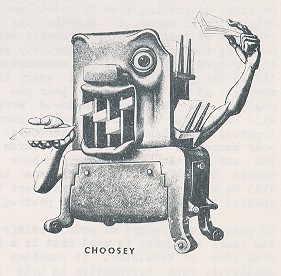
9
|
|
your earnings card and your master card are fed into the collator.
"Choosey" reads the account number and the name on the
card for your wage report. At the same time another part of the
machine reads the account number and name in your master card. Then
"Choosey" compares its reading of your earnings card with
that of your master card. If "Choosey" says it has exactly
the same name on the card, and the same account number, then it
will place your earnings card behind your master card. If there
is some difference in your name or if it finds that you have been
reported with the wrong account number, then your earnings card
will be put to one side by the machine while your master card goes
into the regular file.
Those cards that "Choosey," the collating machine, finds
to be in error as to the spelling of the name, or to have been reported
with the wrong account number, will be checked to find your correct
number. In the event that your correct number cannot be found in
the Division of Accounting Operations because of faulty reporting,
then your employer will be asked to recheck and furnish the correct
social security number for you. If the cards do not match because
of a simple change of your name, or if your name has been misspelled
in making up the earnings report, or in preparing the punch card
for your record, that fact will be discovered in the check to your
established record. The card will be corrected, if necessary, and
the card will then be filed behind the master card for your account.
This whole process of receiving the earnings reports, of putting
them in coded punched hole form in cards, of checking the correctness
of your employer's report, and of matching the card for your quarterly
earnings record with that of the accounts established for you, is
performed every three months. At the end of the year you and most
of the regularly employed workers will have four cards, representing
earnings reports, filed behind the master cards for your accounts.
Then all these cards for you and for the employees who have accounts
established within the same area, will be withdrawn from file and
sent to a special tabulating machine for posting.
In posting the record of your earnings for the year, a machine is
used that is a special form of tabulator. It combines the ability
to read information in code form with the ability to print that
information, and also with the ability to determine from the cards
whether or not your earnings reports are helping you to meet the
insurance requirements that are in the Social Security Act. It is
able to correctly analyze your earnings, it can take totals of those
earnings to show the entire amount that has been paid to you under
the Social Security Act, and at the same time show the total earnings
credited to you for each year. It will print all this information
on a listing.
It will show first of all a summary of all earnings that have been
reported for you until the current year for your account, and then
it will print in detail from your punch cards the record of the
earrings that have been reported for you for each quarter of the
past year. It will show your social security number, your name,
the name or names of your employers, the amount of earnings that
they paid to you and when they paid them. While it is doing this,
the posting machine will check and analyze these earnings reports
to see whether $50 or more for each three month period was posted
to your account. Reports of self-employment income are processed
in much the same manner except that the number of quarters in which
$100 or more of self-employment income has been earned, are recorded.
The reason for this is that your eligibility for retirement benefits
and the eligibility of members of your family to dependents' or
survivors' insurance benefits depend an your "insured status."
10
|
|
The yardstick for measuring whether or not you are insured under
the law is the "quarter of coverage." A quarter of coverage
is a three-month period beginning January 1, April l, July 1, or
October 1-- a calendar quarter--in which you were paid $50 or more
(or in which you were credited with $100 or more in self-employment
income covered by the law).
If your net income from self-employment is $400 or more for a full
taxable year, you will have four quarters of coverage for that year.
The posting machine not only makes these determinations but it will
also indicate whether or not you received earnings in excess of
the maximum in a year, because credit cannot be given to your account
for such excess. The maximum is $3,000 for years before 1951, $3,600
for 1951 through 1954 and $4,200 thereafter. It will determine whether
or not employers have been late in reporting earnings for you so
that a check will be made to insure that you get full credit for
all delinquent earnings reports that have been made by your past
employers for your account. It will list all this information concerning
your record. The machine will then take a series of totals so as
to determine and print on your record the total earnings that have
been paid to you to date and credited to your account, the total
earnings for the current year and for the past three years, the
total number of quarters in which you have been covered for insurance
purposes; and the total number of years of earnings of $200 or more
for years prior to 1951. (In some, relatively few, cases each such
years before 1951 may raise your basic benefit amount by one percent.)
All this information, in addition to being printed on your account
record, will also be punched automatically by another machine that
is a part of the posting tabulator. This other machine is a summary
punch machine and it is very much like the reproducer (the "Hen")
in many ways. It automatically punches into a new master card your
account number, your name, a record of all the earnings that have
been credited to your account to date, a record of your earnings
in each of the last three years and the current year, and the number
of times in which earnings have been delinquently reported for you.
Other information that will be necessary to completely adjudicate
your insurance account and pay to you the proper amount of benefits
is also shown. After the record has been posted, a check is made
to the accounting controls to make certain that the correct amount
of earnings have been credited to your account.
After all your earnings have been posted to your account and the
earnings for all the other folks with social security account numbers
in the same thousand series as you have been posted, the total earnings
for all 1,000 accounts will be checked to the accounting control
figure of the total amount of earnings that have been reported during
the year for those 1,000 accounts. There must be an exact balance
down to the last penny, otherwise a check for the error must be
made and it must be corrected. After the check of the posting totals
has been completed, the posted information is then photographed
and recorded on 16 millimeter microfilm.
During the next year the same operations are performed for every
quarter your employer submits an earnings report for your account.
After it is received by the Division of Accounting Operations, it
is put into punch card form and matched to your master card and
the punch card for your earnings is interfiled behind your master
card. During each quarter the same processes will be performed and
finally at the end of the year your detailed earning's reports will
be posted to your account. Then they will be photographed on microfilm,
the microfilm for the second year's posting's will be spliced to
the microfilm for the first year's postings. Each year this process
is repeated.
Finally, when you apply for your insurance benefits at your local
office, that office requests a certification of your earnings record
from Baltimore. In Baltimore, the spool of microfilm on which your
earnings history is recorded in detail, is withdrawn from the file.
The master card on which the summarization of earnings information
credited to your account is shown, is also withdrawn from files
together with any unposted earnings cards. The earnings information
is summarized to date and as to each calendar year after 1950, and
11
|
|
listed on a form and three cards are prepared to show pertinent
data relating to the account. These cards are run through the "Brain"
the electronic calculating machine. It's in two parts. One is an
electronic calculating machine, the other is a summary punch machine.
Cards can be fed into the latter, the information read off the cards
and into the calculating machine. That machine follows instructions
as programmed for it by a special wiring board which can be changed
at will. The computations can be made at an almost incredible speed.
Using five digit numbers, for example, it computes at the rate of
2,174 additions or subtractions, 79 multiplications, or 65 divisions--in
one second! However, the "Brain" has to slow down to put
its answers in punch card form. Even so, the "Brain" can
multiply or divide with absolute accuracy and punch out its answers
at the rate of 6,000 cards per hour.
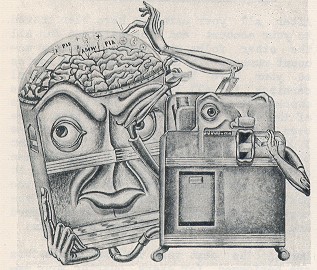 |
|
THE BRAIN
|
The "Brain" computes the average monthly earnings and
the Primary Insurance Amount for earnings from 1937 to date and
from 1951 to date with and without "dropout" of the years
of low or no earnings. This provides a trial benefit computation
which is examined by a claims examiner. The factors are reviewed
and adjusted where necessary, and the information is transcribed
onto the form on which the earnings had been summarized. If the
review indicated that earnings from 1937 to date could provide you
with a higher primary insurance amount than earnings from 1951 to
date or if you are not eligible for the latter computation, the
clerk will check the detailed listing of earnings to provide the
exact data needed for giving the highest benefit amount and that
amount will be computed with the aid of tables and entered on the
form. The form is then certified and forwarded to your district
office where you filed your application for benefits. There your
claim is adjudicated, setting forth the amount of benefits that
are payable.
The "Brain" calculates and punches into the cards containing
the computation factors, its answer as to your average monthly earnings
and your primary insurance amount. After the "Brain" has
processed the cards and made its computations, the cards are then
fed in backwards so that the "Brain's" calculating electronic
impulses will travel in reverse order and the results will again
be punched into your card .
If the "Brain"made an error or if any difference appears
in the two calculations of your benefit, then it will punch a special
symbol in your card calling attention to the difference in the calculation.
The complete record is then sent to an area office, which controls
the payment of claims. There, your name is entered upon the beneficiary
rolls and the Treasury Department is notified monthly to forward
to you, or to you and your wife, if she is also entitled to benefits,
or to your surviving beneficiaries, an insurance benefit check.
It all sounds somewhat complicated when you first see the operations
that are performed in establishing and maintaining your account.
It probably still sounds complicated when you read about it, but
with the aid of "Punch", "Tabby", and all the
other special machines that are used to do the actual work of record
keeping, it is possible for your government to establish an account
for you at a cost of only 13.1 cents. It only costs the Social Security
Administration 3.8 cents to handle your wage report that is received
from your employer from the time of its receipt in Baltimore until
it is processed and posted to your wage record. The average cost
of mechanically maintaining a complete wage history for one year
and posting to it all the detail wage reports received during the
year amounts to only 13.6 cents.
Even if your employer makes a mistake and gives the Social Security
Administration the wrong social security account number in making
his report for you, and it is necessary to check the files and finally
in some cases to communicate with your employer, the entire cost
of handling that item will only average 22.7 cents. If he
12
|
|
fails to show your number at all on his report for you, and
it is necessary to communicate directly with him and obtain your
social security account number, it will only cost 20.5 cents for
handling that item. Of course, the reason for these exceptionally
low cost figures in the administration of the record keeping work
is due to the fact that American ingenuity has provided the mechanical
means for doing the job. From "Punch", who translates
English into coded holes in a cards to "Tabby", who can
read, select, add or subtract such information, print it and summarize
it, or to "Choosey," the collator, who can automatically
read information in two cards and compare the information in both
cards and then either interfile or separate the two cards depending
upon its instructions, the entire system of keeping your insurance
record has been completely mechanized. Maybe tomorrow that same
ingenuity that developed the "Eye" and the "Hen"
will help to further reduce the cost of this record keeping work
through the use of electronic computing machinery and advanced photographic
recording processes.
Of course, while the various operations may appear to be complicated
to one who first sees or hears of them, the use of machines has
so simplified the handling and the processing of the records, that
the only real problem is one of volume. Over 53 million wage reports
are received every three months for the 115 million aocounts that
have already been set up and some 786 machines, with the aid of
4,721 people, work night and day in Baltimore handling this tremendous
volume of reports.
You may be interested in some more of the statistics connected with
this job of keeping your record. If you are, you will find on page
14, a section that is entitled "Highlights" which will
give you more detailed statistical information. If you are interested
in some of the other details relating to the work of handling the
accounting operations, you will also find additional information
concerning the method of coding information on your application
for an account number, partioularly with relation to the Soundex
system of coding surnames. Those who are interested in production
details will find below a description of some of the accounting
and production control records that are kept in order to ensure
the smooth flow of work along the assembly lines from the time of
its receipt as an earnings report from your employer until the time
it is credited to your account.
PRODUCTION CONTROL
The Division of Accounting Operations has to account for every penny
in earnings that is reported for credit to your account. To do this
it establishes and maintains the necessary records to reflect the
status of work in each operation and thus to control effectively
a continuous flow of work through successive operations. This is
accomplished chiefly through the medium of an accounting card mechanically
punched with information relative to each unit of work processed
in each of the major operations. By means of these punched cards
it is possible to determine, for example, the number of employer
reports received daily, batches of work (known as blocks) which
have been unduly delayed in operations within the Division, the
amount of work processed each day in each operation, the amount
of work to be done in each operstion, the location of blocks of
work in operation, and similar control functions.
Your earnings report from your employer is put in a batch with the
reports of your coworkers and others. These batches or units of
work are called blocks. As each unit of work is processed through
various operations, it is accompanied by operation cards. These
operation cards contain various kinds of information useful in preparing
reports and determining the status of units of work. The operation
cards generally show the identifying block number, the number of
items in each block, the total amount of wages, the date the block
was completed in the operation, and other related information. The
operation cards are prepared for each series of
13
|
|
operations and contain the control information needed for the series,
for example: one set of operation cards is prepared for the receiving
operations; one for the counting, examining, batching of employer
reports, for the punching and interpreting of wage cards, and the
balancing of field blocks of employer reports; another for the sorting,
balancing, and filing of blocks; another for collating; another
for the posting to employee accounts. As each unit of work is completed
in an operation, the corresponding operation card is transmitted
to a control section.
In the control branch the data in the operation cards are summarized
and combined with the totals for previous days in order to show
the "to date" status of production. A report is then prepared
by means of a tabulating machine to show the production in each
operation each day, the accumulated production for the period, and
the items in process in each operation. By means of other control
cards the information on this report is supplemented to show the
number of incompletely and incorrectly reported wage items that
are found and the number of these that are correctly identified
each day and other related information.
After the daily production report is prepared, cards for key operations
are retained in file. This file is supplemented by registers which
also show the completion dates of blocks through a number of key
operations. By means of the registers and the operation cards it
is possible to determine the operation being performed on each unit
of work; to notify operating units when blocks have been unduly
delayed in operation, or when blocks must be expedited in order
to close out an accounting period; to check if blocks were lost
in transits; and to secure related information.
Reports as to the production of individual clerks are also prepared.
The source of information for such reports is again the operation
card. From information entered on the face of the card by the operating
unit (such as clerk's number, units, shift, production, and hours)
reports are prepared by tabulating machines relative to clerk, unit
production, and production rates. Such reports are used to make
up an annual report on the efficiency of each clerk, as is demanded
by Civil Service and for various statistical purposes.
HIGHLIGHTS
As of June 30, 1955 there were over 115,000,000 accounts established
and there was a total of 150,487,117 names in the National Employee
Index. This difference is due to the inclusion of cross-reference
names, railroad retirement accounts, and names of people receiving
retirement or survivor's insurance benefits.
With the existing machine and personnel setup, well over 840,000
accounts are processed through every operation every working day.
The following machines are necessary for the task of establishing
and maintaining wage records:
11 Printing Key Punch Machines
387 Punching Machines
58 Sorting Machines
69 Collators
35 Reproducers
37 Interpreters
50 Verifying Machines
16 Alphabetic Accounting Machines
46 Gang Summary Punch Machines
6 Electronic Statistical Machines
2 Electronic Calculating Punches
26 Accounting Machines
42 Numerical Accounting Machines
1 Accumulating Reproducer
A total of 786 electric electric accounting machines of all kinds
are used by the Division of Accounting Operations.
A competent operator can convert into punch-card form approximately
3,000 employee wage items per eight-hour work day. The punching
operation is the slowest of all the machine operations performed
in the installation. Punched cards can be arranged in numerical
sequence at the rate of 1,000 cards a minute for each digit of the
numbers to be put in order. Cards can be tabulated, as many totals
as desired being taken from numerical data punched in the card,
at the rate of 150 per minute. Punch cards can be reproduced with
common information, or punched information in one set of cards can
be reproduced into another at the rate of 100 cards per minute.
The collating machine compares the punching in one set of cards
with that in another set, and interfiles, or distributes cards in
matched or reject pockets at a rate of speed varying from 240 to
480 per minute for both feeds. Average of
14
|
|
9,500 accounts are posted by a single operator in one eight-hour
day.
For every account that has been established, there are the following
records for the wage earners:
Employee Application for an Account Number (Form SS-5)
Employee Actuarial Card
Employee Annual Summary Card
Cross-Reference Employee Actuarial Card (If required)
Entry in the Numerical Register of Accounts Established
Annual Wage Listing
Flexoline Strip (for inserting in the visible index)
Microfilm Copy of SS-5
Form for the State Unemployment Compensation Board
If the employee is known by more than one name, a cross-reference
employee punch card is prepared, and there is a flexoline strip
for each of the names, all bearing the same account number.
As of June 30, 1955, 22,624 file cabinets were being used to hold
all of the material necessary for the establishment and maintenance
of wage records.
The Baltimore office every day receives 18,000 requests for duplicate
account cards.
By microfilming the 115,000,000 original applications for account
numbers, at a photographic reduction of 24 to 1, rolls of film which
contain up to 2,500 images per roll are filed in standard filing
cabinets. The earnings record information of wage earners in covered
employment is also put on microfilm and as a result only 283 standard
filing cabinets are needed to house these film records on 113,955
reels.
CODING
When your application for a social security number is received by
the Division of Accounting Operations some of the information. that
you gave on your application is put in code form in order that it
may take up less room on the master card for your account and also
to make it easier to prepare statistical data from your card.
For example, instead of punching your card to show the words "male"
and "female" a code is used to show this information,
"Male" is coded as "1", "Female" is
coded as "2." Color is also coded. Whites are coded as
"1", negroes are coded as "2" and all other
color classifications are coded as "3." If you are a female
and white, then you would be given code "2" to indicate
that you are a female and, in the proper column of your card, code
"1" to indicate that you are white. If you are male and
a negro then your sex code would be "l" and your color
code would be "2". If you are a male Chinese your codes
would be "l" and "3" for sex and color.
Your date of birth is also coded in that it is converted into figures.
If you had been born on March 6, 1915, for example, your date of
birth would be coded to read "030615." A two digit code
is used for the month and consequently March becomes "03".
A two digit code is used for the day and as a result the sixth becomes
"06". A two digit code, showing just the last two figures,
is used for the year and 1915 consequently is read as "15".
The most important code used is the Russell Soundex code for classifying
surnames. The Soundex system is the basis for a method of filing
where one files according to the first letter and the major sounds
in a person's surname. Under this system every surname can be reduced
to the first letter of the name and three figures. The coding by
figures is done by classifying the consonants in your name according
to their sounds. For the purpose of this coding the vowels "A",
"E", "I", "O" and "U", and
the letters " W", "H", and "Y" are
omitted, and coding is confined to the phonetic grouping of these
major consonants in your name. For example, the letters "D"
and "T" sound very much alike, hence they are coded with
one code figure, a "3". "M" and "N"
also sound alike and they are given only one code figure -- "5".
"L" has a distinctive sound and is coded alone as "4".
"R" too
15
|
has a distinctive sound and it is coded as "6." The letters
"B", "P", "F" and "V", however,
are somewhat alike in sound , being labials, and they are all coded
as "1". The "ka", "guh" and "suh"
sounds, including all of the sibilants, such as "C", "G",
"J", "K", "Q", "S", "X"
and "Z" are all grouped together as "2". The code
grouping therefore, is as follows:
| Letters |
Code Symbol |
B, P, F, V
C, G, J, K, Q, S, X, Z
D, T
L
M, N
R |
1
2
3
4
5
6 |
In coding we eliminate the vowels and take the first letter of the
name and the code symbols for each of the first three major consonants.
In the event that there is a double consonant without an intervening
letter only the first consonant is coded. In applying this rule we
consider consonants by the code grouping. Therefore a "C"
followed by a "K", without an intervening letter, would
be considered as a double consonant (they both are coded as "2")
and we would only code the first letter, the "C". This rule
also applies to the initial and second letter of the name. For instance
if we started to code the name "Schneider" we would take
the first letter "S" as part of the code. Then we would
start to code the "c" as the first consonant and discover
that it was in the same consonant group as the "S" without
an intervening letter. We would consider it a double consonant and
not code the "c". Going a step further with this example
we wouldn't code the letter "h" at all nor the vowels "e",
"i" and "e". We would have left three consonants
to code, the "n", the "d," and the "r",
which would be coded respectively as "5", "3"
and "6" so that we would have the final code as "S536"
for the name Schneider. Schneider can be spelled in some twenty-nine
different ways, yet by using this method of coding the name will always
be coded as "S536." Let's take a look at a few examples,
strike out the non-coded letters and see what the resulting code is.
Among other variations the name may be spelled Snyder, Sneider, Snider,
Schniter, Sneidor or Sniedar. By striking out the non-coded letters
and coding those that are left we get:
SNYDER
SNEIDER
SNIDER
SCHNITER
SNEIDOR
SNIEDAR
SCHNEIDER |
S536 |
If the name to be coded does not have three significant consonants
then zeros are added to give a three digit code. For examples, with
the name "Carr" we have the "C", the first letter,
as part of the codes the "a" is not coded and the double
consonant "rr" is coded as "6." To make a three
digit code we add "00" and the code becomes "C600."
With a name such as "Ray" where there are no significant
consonants we use the first letter and three zeros so that "Ray"
becomes "R000." Other examples are:
WAY
BAER
BROWN |
W 000
B 600
B 650 |
|
|
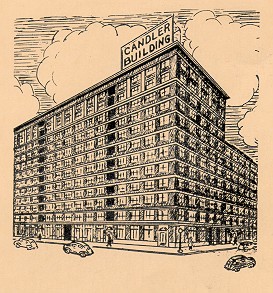
|





